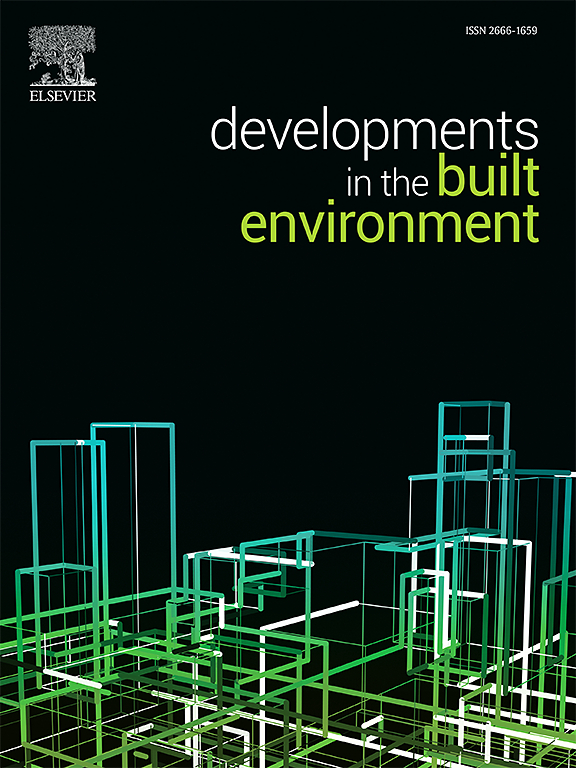通过与共享交通车辆相结合的驾驶式监测,对一座人行天桥进行试验性模式识别
IF 6.2
2区 工程技术
Q1 CONSTRUCTION & BUILDING TECHNOLOGY
引用次数: 0
摘要
在提高交通基础设施抗灾能力的背景下,一种新出现的间接结构健康监测方法正受到越来越多的关注,这种方法被称为 "驾车监测",即在车辆上安装传感器,以评估其经过的桥梁。然而,这种方法的有效性主要是在理想情况下进行研究的,实际应用还很少。本文介绍的研究探讨了将两条路线结合起来的可行性:(1)减少车队排放;(2)通过将驾驶监测与共享交通(包括电动代步车和自行车)相结合,增强交通恢复能力。从共享交通中收集的驾驶数据信息可以提供重要交通基础设施(如桥梁)的宝贵信息,这样的驾驶数据库有可能用于网络级基础设施状况评估。本文根据桥梁的灵活性研究了两种不同的绕行路线图,即部分绕行监测或完全绕行监测。为了验证所提出的路线图,选择了一座完整规模的人行天桥进行绕行测试,在共享移动装置上安装智能手机传感器和专用加速度计以获取数据。实验结果表明:(i) 与专用加速度计相比,智能手机传感可提供相似精度的数据;(ii) 桥梁频率可从临时停放的共享移动设备上轻松获取,最大相对误差为 1.05%;(iii) 通过使用变模分解和滤波技术,可从移动的共享移动设备上成功提取桥梁频率和运行挠度形状,并可收集共享移动设备的 GPS 数据和移动速度,用于潜在的车辆定位和驾车测试数据库更新。本文章由计算机程序翻译,如有差异,请以英文原文为准。
Experimental modal identification of a pedestrian bridge through drive-by monitoring integrated with shared-mobility vehicles
In the context of improving resilience in transport infrastructure, an emerging approach of indirect structural health monitoring is gaining attention, known as drive-by monitoring, instrumenting a vehicle with sensors to evaluate the bridges it crosses. However, their effectiveness has predominantly been investigated in ideal scenarios, with actual real-world applications being quite scarce. The research presented in this paper explores the feasibility of combining two routes: (1) fleet emissions reduction and (2) transport resilience enhancement, through drive-by monitoring integrated with shared mobility, including electric mobility scooter and bicycle. The information from drive-by data collected from shared mobility can give valuable information on critical transport infrastructure (e.g., bridges) and such a drive-by database has the potential for network level infrastructure condition assessment. In this paper, two different drive-by roadmaps are investigated subject to the flexibility of the bridges, namely partially or fully drive-by monitoring. To validate the proposed roadmaps, a full-scale pedestrian bridge was chosen for drive-by testing, where smartphone sensors and specialised accelerometers are mounted on shared mobility for data acquisition. Experimental results demonstrate that (i) smartphone sensing can provide data with similar accuracy compared to specialised accelerometers, (ii) bridge frequencies can be easily obtained from temporarily parked shared mobility, with a maximum relative error of 1.05%, (iii) both the bridge frequencies and operational deflection shapes are successfully extracted from the moving shared mobility by using variational mode decomposition and filtering techniques, and shared mobility's GPS data along with moving speeds are collected for potential vehicle positioning and drive-by database updating.
求助全文
通过发布文献求助,成功后即可免费获取论文全文。
去求助
来源期刊

Developments in the Built Environment
Multiple-
CiteScore
7.40
自引率
1.20%
发文量
31
审稿时长
22 days
期刊介绍:
Developments in the Built Environment (DIBE) is a recently established peer-reviewed gold open access journal, ensuring that all accepted articles are permanently and freely accessible. Focused on civil engineering and the built environment, DIBE publishes original papers and short communications. Encompassing topics such as construction materials and building sustainability, the journal adopts a holistic approach with the aim of benefiting the community.
 求助内容:
求助内容: 应助结果提醒方式:
应助结果提醒方式:


